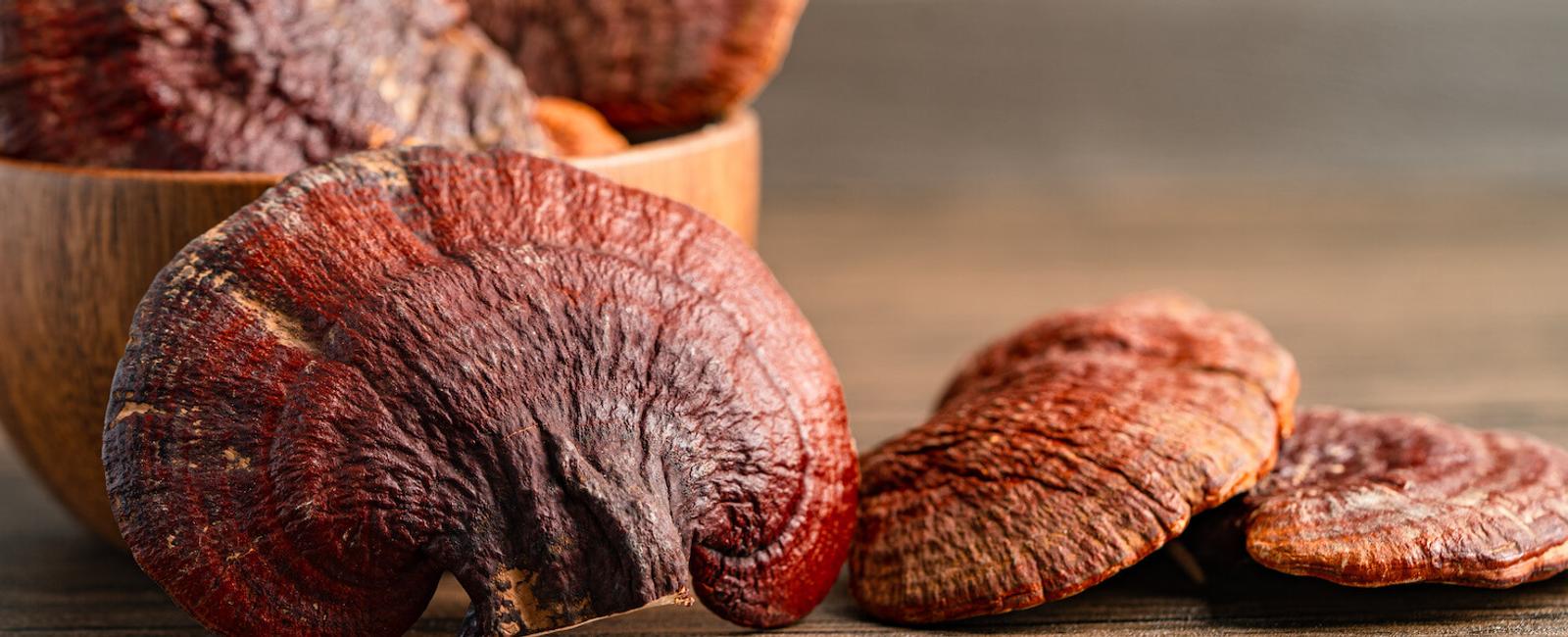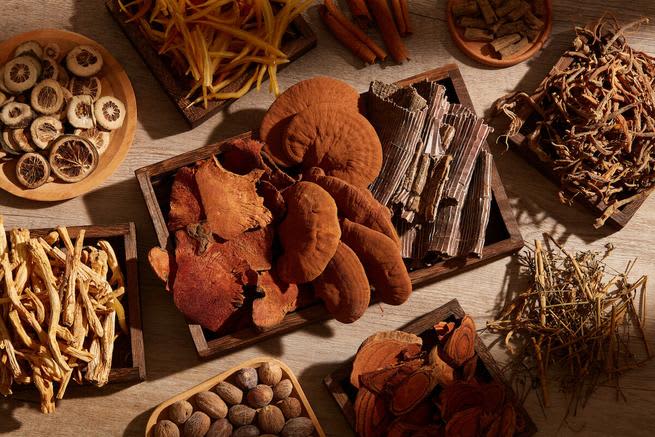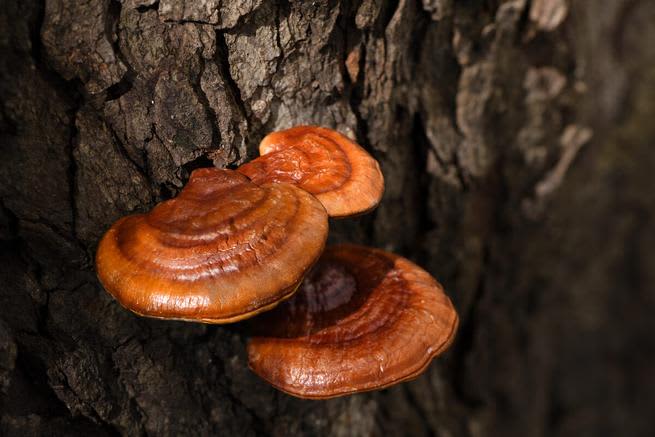

It’s clear medicinal mushrooms are having more than a moment. And while it may seem like this is a recent health trend, cultures worldwide have used these sacred mushrooms for centuries to support their health and wellness.
But only certain fungi have reached the status of reishi mushrooms. Known as the “mushroom of immortality” and the “queen healer mushroom,” reishi mushrooms have been an essential staple ingredient of herbal medicine.
In this guide to reishi mushrooms, we’ll talk more about their characteristics, how to identify and consume them, and how modern medicine is confirming what traditional medicine has known for ages.
What are reishi mushrooms?
Reishi mushrooms (Ganoderma lucidum), which also go by the name of lingzhi, are medicinal mushrooms. The name, Ganoderma, means “shiny skin,” and reishi is the best-selling medicinal mushroom. You may also see reishi called the mushroom of spiritual potency and lacquered polypore (1).
What do reishi mushrooms look like?
There are five different species of reishi mushrooms, each with slightly different beneficial properties: yellow, white, red, black, and purple. Reishi mushroom colors may vary throughout the year and according to their environment, so red reishi can sometimes be yellow or orange.
Several mushroom species look like reishi, and while they can have similar properties, they aren’t the same as reishi. Proper identification is essential if you’re looking for actual reishi mushrooms.
Reishi mushrooms don’t look like the typical mushrooms you see in your local supermarket. These mushrooms have a more fan-shaped cap and a tough, woody texture. Think more along the lines of turkey tail mushrooms rather than cremini mushrooms.
Lingzhi doesn’t have gills like a cremini mushroom does, either. Instead, they have light undersides with tiny little pores (1). Depending on how much oxygen is in the environment, reishi mushrooms can develop finger-like antlers too (2).
Where do reishi mushrooms grow?
Reishi mushrooms tend to grow in a shelf-like arrangement on dying trees or fallen logs. However, it’s not unusual to find them growing on the ground too.
Reishi mushrooms grow in a wide variety of areas, from South America to Asia. Different types of reishi mushrooms grow in different environments, from tropical and subtropical to temperate climates (2).
Historical and medicinal use of reishi mushrooms

Reishi has a long history in traditional Chinese medicine, appearing in the first Materia Medica compiled in the first century. It was often used in herbal formulations that would grant youth and longevity (3).
In Eastern medicine, reishi mushrooms are used to affect the heart, kidney, lung, liver, and spleen meridians. In addition to those meridians, reishi mushroom has a calming effect on the shen while nourishing both qi and jing—shen (psyche), qi (vital force or vital energy), and jing (kidney essence) are known as the three treasures, which are considered the fundamental elements of health.
Medicinal use for reishi mushrooms has included treating insomnia, and anxiety, calming allergic reactions, reducing arthritis, improving lung health, enhancing immunity, and promoting spiritual and emotional well-being (4).
Health benefits of reishi mushrooms
The benefits of reishi mushrooms are remarkable as they foster whole-body wellness. Asian medicine has known about reishi benefits for centuries, and modern medicine is validating such findings through in vivo and in vitro studies. Here are some of the ways reishi mushrooms can potentially improve your well-being.
- Adaptogenic: This mushroom is considered adaptogenic, which helps your body adapt to mental and physical stressors. It can balance stress hormones and improve cognitive function (1); small clinical trials have shown how reishi may alleviate anxiety and depression (5). Its effect on brain health may also stave off Alzheimer’s.
- Better heart health: Reishi mushrooms have demonstrated an ability to positively impact heart health by regulating cholesterol levels and helping to lower blood pressure.
- Control inflammation: These medicinal mushrooms have anti-inflammatory properties; the combination of polysaccharides like beta-glucans, triterpenes, and peptides positively impacts inflammation levels in the body. Plus, their high antioxidant content helps safeguard against free radicals, which can lead to pain and disease.
- Immunomodulation: Like other systems in the body, reishi mushrooms can positively affect the immune system and immune function as they can increase natural killer cell activity (1). Further studies demonstrate an ability to suppress the migration of cancer cells with both breast and prostate cancer (6). Even more, reishi mushrooms can mitigate the side effects of cancer treatment, improving the quality of life for cancer patients.
- Blood sugar management: Reishi’s positive effect on blood sugar can mean decreasing the risk of kidney issues in patients with type 2 diabetes. One study found the compounds in reishi mushrooms inhibit an enzyme that produces glucose (5).
If you’re still determining whether or not reishi mushroom is right for you, be sure to consult with your healthcare provider.
Psst: Herbalist Ron Teeguarden has spoken of “reishi babies,” referring to mothers who’ve taken reishi during their pregnancy and while breastfeeding. According to Teeguarden, reishi babies are calmer, more focused, peaceful, and adapt more readily to their surroundings (7).
Ethically wildcrafting reishi mushrooms

Before you venture out into the wild unknown and gather your own reishi mushrooms, it’s necessary to consider the differences between foraging and ethically wildcrafting. It’s easy to think these are synonyms for each other. While they are related, the approaches behind foraging and wildcrafting can differ.
Foraging often refers to collecting wild food sources, while wildcrafting involves harvesting wild resources for medicinal needs.
Where the philosophy behind foraging often begins and ends with gathering mushrooms (or herbs, plants, berries, nuts, and other wild foods), wildcrafting involves more mindful consideration behind harvesting and its impact on the ecosystem.
Before you set out to gather your wild mushrooms, it’s always a good idea to familiarize yourself with the local mushroom species in your area. Are there dangerous lookalikes you need to be aware of? What about threatened or endangered mushroom species?
Something else to consider is how you’ll harvest your mushrooms and whether you have the proper tools and equipment. Most of the time, when we think we’re seeing the whole mushrooms, we’re just seeing the fruiting bodies, which is just the tip of the iceberg. Beneath the surface, there’s a fundamental other part of mushroom anatomy we may be unfamiliar with: the mycelium.
The mycelium is a massive network of delicate filament-like structures called hyphae that help facilitate communication. Sometimes called the “wood wide web,” all sorts of important information is carried along this plant-based super highway. Mycelia can communicate about changing water levels and even warn of predators in the area. Proper harvesting means the difference between leaving this network intact or damaged.
Take the time to learn the difference between foraging and ethical wildcrafting so we all get to enjoy nature’s gifts for years to come.
How can you enjoy reishi mushrooms?

Like chaga mushrooms, reishi mushrooms aren’t the kind of mushrooms you want to throw in your stir-fry or morning omelet. They have a tough and woody texture, so you’ll be much happier choosing a culinary mushroom like enoki or morel mushrooms when experimenting in the kitchen.
Instead, keep your eyes open for reishi mushroom extract or mushroom supplements that include reishi mushroom as an ingredient.
A mushroom powder is a quick and easy way to include medicinal mushrooms throughout your day. In addition to organic reishi mushrooms (more on why this is a wise choice soon), mushroom powders often have other supportive mushrooms that help boost immunity, soothe the nervous system, or increase brain health. Shiitake, cordyceps, lion’s mane, maitake, and turkey tail mushrooms are all deeply nourishing to the body.
Suppose you are more interested in seeing how your body responds to reishi mushrooms alone, without being part of a blend. In that case, you’ll want to look for a tincture or single blend instead.
Because of how dietary supplements are regulated (it can vary by country) and the surge in popularity of mushroom supplements, there are some things to keep in mind when you’re choosing how to enjoy your reishi mushroom.
- Extraction method: Different extraction methods yield different medicinal properties. For example, the health properties of water extraction will be different from those of alcohol extraction. This is one reason you may want to look for reishi mushroom products labeled as dual extraction, which means you’ll enjoy the full spectrum of health benefits reishi mushroom offers.
- Organic vs. wildcrafted: Mushrooms are known to absorb pesticides and other substances in their environment, which makes paying attention to sourcing even more critical. While the organic label can offer peace of mind, some small growers may practice the same methods as organic mushroom farming, albeit without the organic certification. There are also reishi mushrooms grown in the wild and removed from human influence on their environment. These wildcrafted mushrooms are sometimes thought to have even more benefits than their organic counterparts but keep in mind that environmental toxins could also impact these fungi.
- Growing substrate: Since mushrooms absorb so much from their environment, the substrate they’re grown in can impact their health benefits. Different substrates can mean different nutrient profiles, their bioactive compounds, and even flavor and aroma.
Reishi mushrooms: A natural choice to improve your well-being
Reishi mushrooms are an ideal complement to any wellness routine. They’re deeply nourishing to the body, supporting immune health, heart health, managing stress, and even offering a sense of calm and peace of mind.
For more mushroom happenings, including news and breakthroughs on medicinal and psychedelic mushrooms, be sure to keep up with us on shroomer.
References
Hobbs, Christopher, PhD. Christopher Hobb’s Medicinal Mushrooms: The Essential Guide. Storey Publishing, LLC, 2021. https://christopherhobbs.com/hobbs-news-archive/christopher-hobbss-medicinal-mushrooms-the-essential-guide/.
Support, Extension Web. “Non Timber Forest Products for Small Woodland Owners: Reishi Mushroom Growing Guide.” OSU Extension Service, September 28, 2022. https://extension.oregonstate.edu/catalog/pub/em9364.
Hoffman Chiropractic Centre. “Reishi Mushrooms: King of Herbal Medicine | Hoffman Chiropractic Centre,” January 31, 2018. https://drdebrahoffman.com/nutrition/reishi-mushrooms-king-of-herbal-medicine/.
White Rabbit Institute of Healing. “Reishi.” Accessed June 5, 2023. https://www.whiterabbitinstituteofhealing.com/herbs/reishi/.
Morton, Katie, and Katie Morton. “Reishi Mushrooms Are Popping Up in More Wellness Products, but What Are the Benefits?” Well+Good, November 8, 2022. https://www.wellandgood.com/reishi-mushroom-benefits/.
Chen, Zhixian, Jianfeng Gan, Zhi Wei, Mo Zhang, Yan Du, Congjian Xu, and Hongbo Zhao. “The Emerging Role of PRMT6 in Cancer.” Frontiers in Oncology 12 (March 4, 2022). https://doi.org/10.3389/fonc.2022.841381.
Hedley, Eliza. “How Safe Is Herbal Medicine While Pregnant and Breastfeeding.” Teelixir, June 8, 2020. https://teelixir.com/blogs/news/safe-herbal-medicine-pregnant-breastfeeding#reishibabies.


